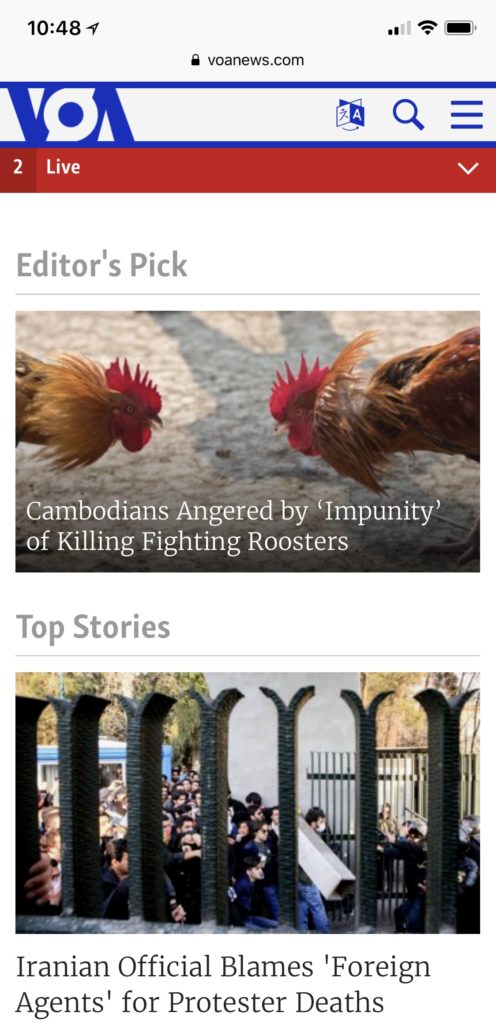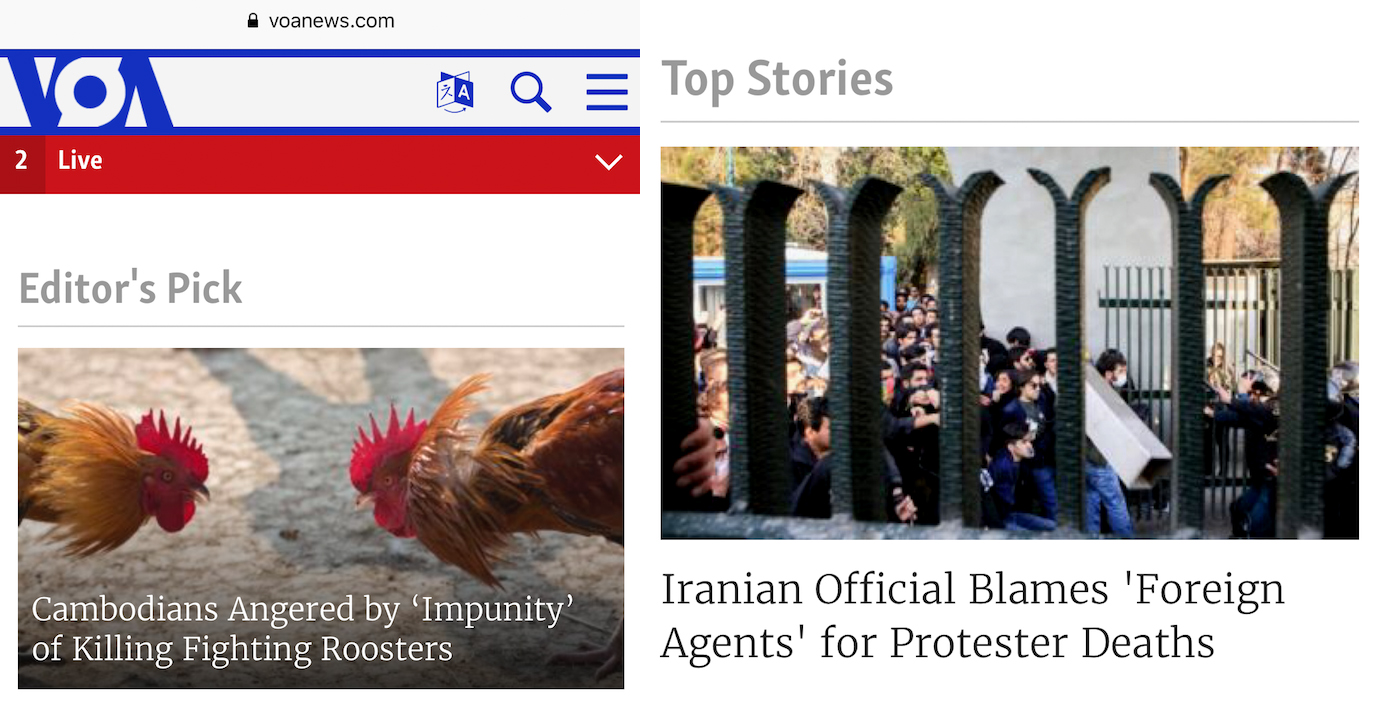BBG Watch Guest Commentary
by Ted Lipien

Voice of America (VOA), the U.S. taxpayer-funded ($224 million FY 2017) U.S. government-run media outlet which is part of the dysfunctional and mismanaged Broadcasting Board of Governors (BBG) federal agency ($740 million with VOA) once described by Hillary Clinton as “practically defunct,” had this morning a “superbly balanced” (please excuse sarcasm) “news report” on demonstrations against the regime in Iran.
True, some of the other side’s story, i.e. Iranian demonstrators,’ was included in the VOA report, but it was very little, and almost as an afterthought.
Very brief descriptions of U.S. State Department’s and Trump’s statements were added at the very end.
The VOA report was almost entirely written up to highlight what the Iranian regime officials in charge of propaganda wanted to convey to the gullible and the poorly informed.
Since this morning, VOA News has made several changes to the story, including giving it a new headline. It is still pretty bad.
Yes, I do know that sometimes VOA has to report even obvious lies if they qualify as newsworthy despite being lies, but VOA does not have to elevate them to the same level as the truth, which VOA News did in this case. There is such a thing as countering lies, propaganda and disinformation with facts.
It almost seems that the ghost of Ben Rhodes, President Obama’s chief propagandist on Iran, is still hovering over the VOA Newsroom. I remember when I gave a TV interview to the VOA Persian Service several years ago, I was sternly told by the Farsi service producer not to dare to speak about “regime change” in Iran when discussing Solidarity workers’ strikes in Poland in the 1980s.
Actually, one could see the latest VOA headline as an improvement (again, sorry for the sarcasm) because for nearly two days VOA English News homepage showed no reports on the Iranian demonstrations.
Also note the curious VOA “Editor’s Pick” at the top of the VOA mobile site about dying roosters on the day Iranian demonstrators are being killed. Dying roosters in Cambodia were presented at the very top while the VOA headline below informed the relatives of killed Iranians that they were murdered by “Foreign Agents,” possibly Americans.
Is this how the new VOA, still managed by Obama administration holdover officials, engages with the audience “in support of freedom and democracy”?
All I can say is that the Voice of America I worked for in the 1980s, and from where I retired in 2006 as acting VOA deputy director, did not write such headlines and leading paragraphs about any of the obvious lies the Jaruzelski military regime put out about strikes and demonstrations of Solidarity workers and their supporters in Poland.
While we reported on what the Jaruzelski junta said, its lies were not being reported then by VOA the same way as truthful information. I don’t deny that every media organization, even the best ones, has a certain degree of bias. At the very least, in the case of VOA it should not be a bias in favor of dictators and their lies and propaganda. The leaders in charge of the Voice of America should be biased in favor of truth, freedom and democracy because that is what America stands for and that’s what the VOA Charter says it should do.
END OF COMMENTARY
Disclosure: Ted Lipien is one of the co-founders and supporters of BBG Watch.
###
VOICE OF AMERICA
Text Only captured at 10:48 AM ET, Sunday, December 31, 2017
Iranian Official Blames ‘Foreign Agents’ for Protester Deaths
December 31, 2017 7:53 AM
VOA News
An Iranian official is blaming “foreign agents” for the shooting deaths of two protesters during widespread anti-government demonstrations Saturday.
“No shots were fired by the police and security forces,” Habibollah Khojastehpour, a deputy governor of the province where the protesters were killed. “We have found evidence of enemies of the revolution, Takfiri groups and foreign agents in this clash,” he said in an interview on state television Sunday.
The shootings happened in the western town of Dorud on the third day of protests. VOA’s Persian service identified the victims as Hamzeh Lashni and Hossein Reshno after a reporter spoke to the victims’ families.
Video posted to social media purported to show the two victims following the shootings. Other online video showed thousands of people protesting in several cities throughout Iran — including some attacking government buildings and violently confronting police.
There were reports that mobile devices were unable to access the internet for a period of time Saturday, though coverage was restored later in the day. But Iranian media reported on Sunday that access to some photo and message sharing apps was again restricted.
Protesters will ‘pay the price’
Earlier Sunday, Iran’s interior minister warned that those who “disrupt the order and break the law must be responsible for their behavior and pay the price.” Abdolrahman Rahmani Fazli, in a statement on state television, said “fear and terror will definitely be confronted.”
The uprisings — the biggest and most sustained since the 2009 presidential election protests — were sparked by high food prices and the country’s high unemployment rate. As many as 72 people died in the 2009 unrest after the regime cracked down demonstrators challenging the reelection of then-President Mahmud Ahmadinejad.
The latest demonstrations were seen as a cry against President Hassan Rouhani, who won re-election in May with promises to revive the economy.
Iran’s 2015 nuclear deal is seen as Rouhani’s major achievement. The deal, made with the United States and five other world powers, curbed Iran’s nuclear activities in exchange for relief from international sanctions. But economic growth has not followed, and people are struggling to cope with the high cost of living.
Iran’s unemployment rate is 12.4 percent, its economy stagnant and inflation rampant
Little information about the protests is available, however, because state-run and semi-official news media have not widely reported on the demonstrations.
As a counter to the violence, separate state-sponsored rallies took place around the country to mark the end of the unrest that shook the country in 2009. State television reported pro-government rallies were held in about 1,200 cities and towns.
Cautions on social media use
Iran’s telecommunications minister Mohammad Javad Azari Jahromi sent a public message to the CEO of the messaging service Telegram, telling him, “A Telegram channel is encouraging hateful conduct: use of Molotov cocktails, armed uprising, and social unrest.” Telegram responded saying it had suspended the account.
Telegram CEO Pavel Durov also tweeted a public message, explaining why the account was suspended.
“A Telegram channel [amadnews] started to instruct their subscribers to use Molotov cocktail against police and got suspended due to our ‘no calls for violence’ rule. Be careful,” Durov said. “There are lines one shouldn’t cross.”
A prominent cleric, Ayatollah Mohsen Araki, told thousands of pro-government demonstrators in Tehran that “the enemy” wanted to use social media and economic issues to “foment a new sedition.”
State television broadcast images of the protests Saturday, something it rarely does, including acknowledging that some of the demonstrators were chanting the name of Iran’s last shah, who fled the country during the Islamic Revolution in 1979.
Reaction
U.S. President Donald Trump denounced the Iranian government Saturday, tweeting excerpts from his September 19 speech to the U.N. General Assembly. He charged Rouhani’s government, and those before it, have long oppressed the Iranian people.
In a statement Friday, the U.S. State Department said, “Iran’s leaders have turned a wealthy country with a rich history and culture into an economically depleted rogue state, whose chief exports are violence, bloodshed and chaos.”
The State Department urged “all nations to publicly support the Iranian people and their demands for basic rights and an end to corruption.”
RFE/RL contributed to this report.
END OF VOA REPORT
